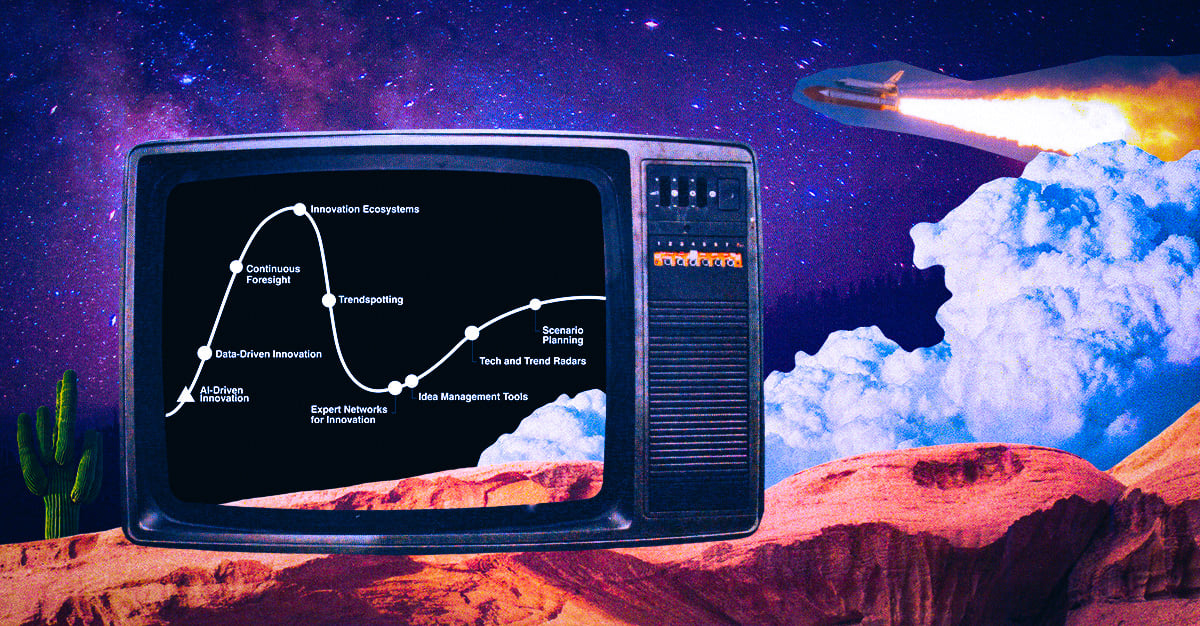As advised by Gartner®, executive leaders and innovators must pay attention to selecting techniques that will best serve their innovation goals, following best practices, and avoiding common pitfalls. It is imperative to fully understand the practices available for teams to find and select the most promising innovation techniques suited to their business context. The below glossary of terms defines some of the key innovation management techniques in the 2021 Gartner® Hype Cycle™ available to practitioners.
Glossary of Terms: Innovation Management Techniques
AI-Driven Innovation
Gartner explains, “AI-driven innovation refers to the use of artificial intelligence technologies in the process of innovation. AI-driven innovation could either be in the form of new inventions like new drugs or material discovery in specific domains or could be used to boost agility and efficiency in an end-to-end innovation process pipeline across use cases and industries.”
Read more about AI-driven innovation.
Data-Driven Innovation
Data-driven innovation (DDI) "refers to the use of data and analytics (D&A) to develop or foster new products, processes, organizational methods and markets. D&A can drive both the discovery and execution of innovation, achieving new business models, products and services with a confirmed business value.”
Read more about data-driven innovation.
Corporate Incubators
As per Gartner, "Corporate Incubators are enterprise-led innovation accelerator that provides early-stage ideas with the support and guidance they need to develop business models that will be released to the market under the corporate entity. The incubator acts as a catalyst for the corporation to stimulate innovation and develop a pipeline of successful new ventures. It provides facilities, advice, training, funding, and market and scale capabilities.”
Continuous Foresight
Continuous foresight "leverages the best practices of strategic/corporate foresight and futurism to continuously identify business models and strategies, and determine how to adjust either or both to create future success. Continuous foresight is a methodology applying a discipline to identifying and assessing trends and projections, as well as backcasting from desirable futures. Continuous foresight will help support the process of preparing for and responding to a world of continual change."
Read more about continuous foresight.
ISO 56000
Gartner explains, “ISO 56000 is a family of guidance standards addressing many aspects of innovation management including innovation processes, partnerships, terminology, strategic intelligence, idea management, assessment, intellectual property management and measurement. Innovation is a key competitive differentiator for most organizations, and most organizations believe they could be more effective at innovation. Surveys suggest that organizations that adopt a structured approach to innovation are more successful than those that don’t. The ISO 56000 family of guidance standards provides a framework for many of the key practices required for innovation success."
Innovation Centres of Excellence
Innovation Centres of Excellence "are competency or capability center run by a group of experts. It is usually built around critical processes, technologies or applications to help the company eventually become more innovative. It’s a team, shared facility or think tank that provides best practices, leadership, research, training and/or support for innovation-related competencies."
Innovation Storytelling
As per Gartner, "Innovation Storytelling is the sharing of stories to deliver innovative ideas in compelling, easily assimilated forms. Stories are intended to prompt interaction, discussion and collaborative decision making."
Innovation Ecosystems
Innovation ecosystems "exploit partnerships to accelerate innovation, reduce risks, leverage shared capabilities, share costs and access a larger pool of ideas. Ecosystems may take many forms, including commercial or academic partnerships, shared R&D facilities, or government initiatives."
Read more about innovation ecosystems.
Digital Safaris
Gartner explains, "A digital safari involves visiting multiple organizations (in person or virtually) to learn about, engage in and develop a deeper understanding of their digital initiatives, innovations and/or transformations. Visits may last from a half-hour (e.g., a startup pitching at a VCs premises) to a full day (e.g., a tour of innovations from a digital giant), over contiguous days or spaced out over time, and may include presentations, demonstrations, hands-on experiences, Q&A and facility tours."
Innovation Culture Hacks
Culture hack "is a small adjustment to an individual’s behavior where that change will create a larger, more wide-ranging change in the culture of the organization. Innovation requires culture that empowers innovators to be creative and innovative."
Lean Startup
As per Gartner, "Lean startup is an innovation technique that accelerates the speed of product development and enables rapid testing and aligning business model fit. First developed by entrepreneurial startups, it is now successfully being adopted in the IT organizations of large, mature enterprises, which are seeking to emulate the principles of intrapreneurship, validated learning, innovation accounting and build-measure-learn."
Trendspotting
Trendspotting "is the acquisition and evaluation of trends that may impact the organization. A trend describes an observation or prediction about changes in the environment that gain momentum occurring over time and can be observed. Trends can be historical observations or an extrapolation into the future with predictions on the direction or speed of change."
Read more about trendspotting:Design Thinking
Gartner explains, "Design thinking is an ideation methodology extracted from the broader, multidisciplinary design process used in the creation of physical and digital products."
Innovation Hubs
Innovation hub "comprises a system of connections that puts the enterprise at the center of a hub, together with startups, incubators and accelerators to transform innovative ideas into technologically feasible solutions. Innovation hubs are often housed in specific geographic concentrations to accelerate ideation, gain access to talent, nurture unique culture and encourage entrepreneurship."
Expert Networks for Innovation
As per Gartner, "Expert networks offer access to prescreened experts on specific topics who may assist an organization in problem solving or opportunity generation as part of the organization’s open innovation activities."
Idea Management Tools
Idea management tools "help organizations manage the flow of ideas from initial concept generation to their final realization or commercial exploitation. They support different ways to generate ideas internally or externally. This includes challenges, brainstorming or hackathons; stage-gate automation for idea evaluation and selection; and ways to manage a portfolio of active ideas (including idea execution to take ideas to realization via project or product management)."
Read more about idea management tools.
Innovation Labs
Gartner explains, "An innovation lab is a unit within the organization whose mission is to devise novel ideas that can either disrupt or complement the rest of the organization, and to deliver business-relevant outcomes. While the execution may involve creativity, exploration and incubation, the viability of the lab hinges on its contribution to the strategic objectives and goals of the organization. A lab is typically run out of a distinct physical space to emphasize the separation from business as usual."
Open Innovation
Open innovation "is an approach that sources ideas from outside the organization and also shares unused or underutilized ideas in the opposite direction with customers and partners. Over the last two decades, it has become an essential component of many corporate innovation programs. It was first proposed by Professor Henry Chesbrough of UC Berkeley in his book, “Open Innovation: The New Imperative for Creating and Profiting from Technology” in 2003."
Read more about open innovation.
Tech and Trend Radars
As per Gartner, "A technology and trend radar is a customizable visualization tool that shows the current and future trends that your organization has identified as being impactful. It can also be used to track and prioritize discrete technologies and broader trends composed of multiple technologies moving in the same direction. Such radars help an organization prioritize investments by showing which technologies and trends are important and when they should be acted on."
Read more about tech and trend radars.
Innovation Training
Innovation training "is a program that equips learners to understand and leverage innovation theories, frameworks and techniques. It teaches how to align resources and processes to develop an innovative culture, harness new opportunities rapidly, and pursue creative disruption to ignite growth. It broadly includes internally developed training programs and courses, massive open online courses (MOOCs), third-party training institutes and structured innovation programs from research universities."
Business Model Frameworks
Gartner explains, "Business model frameworks are strategic innovation management and entrepreneurial tools that allow the organization to describe, design, adapt, invent and pivot their business models. Mainstream business model frameworks include Gartner’s Business Model Framework and Strategyzer’s Business Model Canvas."
Hackathons
Hackathons "are a competitive design activity involving development of a prototype or app, usually in one to two days. Assigned or self-selected teams work in parallel on a goal or challenge, and come together at a fun final event to pitch and compete for prizes. These sometimes involve outside participants (universities, startups or citizens). Outside IT, these are sometimes called innovation days, and are used to rapidly prototype plans, products/services, and customer or employee experiences."
Internal Pitch Events
As per Gartner, "An internal innovation pitch event — also sometimes called a “Shark Tank” or “Dragon’s Den” — is a venture-capital-style competition in which individuals or teams present ideas to a panel of judges (which could be an innovation committee or a group of executives). Judges ask penetrating questions about the idea, and ultimately accept or reject each idea for backing or onward investment."
Scenario Planning
Scenario planning "is a management methodology that helps organizations prepare for uncertainty by envisaging and analyzing plausible future outcomes. The methodology assesses critical uncertainties and macroforces influencing or impacting the market and enterprises, stimulating executive thinking. Executives can “future test” their strategies and promote innovation by ideating opportunities, risks and actions to capture stakeholder returns."
Read more about scenario planning.
Idea Challenges
Gartner explains, "An idea challenge is a time-bounded request for ideas to solve a particular business problem or address an opportunity. A challenge usually lasts from a few days to a few weeks, and targets a diverse population of participants. To reach the broad population and to manage the ideas collected, a challenge is typically run through an online innovation portal, often using an ideation tool."
Read more about idea challenges.
Innovation Governance Committees
An innovation governance committee "is a group of people who are chosen to supervise, lead and govern innovation-related matters for their organization. It is the highest level of authority of the innovation governance structure in an organization."
Innovation Workshops
As per Gartner, "Innovation workshops are event-based, highly collaborative sessions that last from a couple of hours to a couple of days in duration. These workshops typically include one or more process steps, ranging from idea capture (like ideation), to idea categorization and discussion (such as, elevator pitches), to idea prioritization (such as voting) and then to high-level business cases and roadmaps. They complement longer-duration innovation campaigns and maybe run internally or externally."
Get more exclusive insights and first-hand recommendations from Gartner® →
Disclaimer
Gartner does not endorse any vendor, product or service depicted in its research publications and does not advise technology users to select only those vendors with the highest ratings or other designation. Gartner research publications consist of the opinions of the Gartner Research & Advisory organization and should not be construed as statements of fact. Gartner disclaims all warranties, expressed or implied, with respect to this research, including any warranties of merchantability or fitness for a particular purpose.
This graphic was published by Gartner, Inc. as part of a larger research document and should be evaluated in the context of the entire document. The Gartner document is available upon request from ITONICS. Gartner, Hype Cycle for Innovation Management Techniques, 2021, 12 July 2021, Jackie Fenn et. Al. GARTNER and Hype Cycle are registered trademarks and service marks of Gartner, Inc. and/or its affiliates in the U.S. and internationally and are used herein with permission. All rights reserved.



/Assets%20and%20Heros/nav-thumbnail-Gartner.webp?width=150&name=nav-thumbnail-Gartner.webp)







